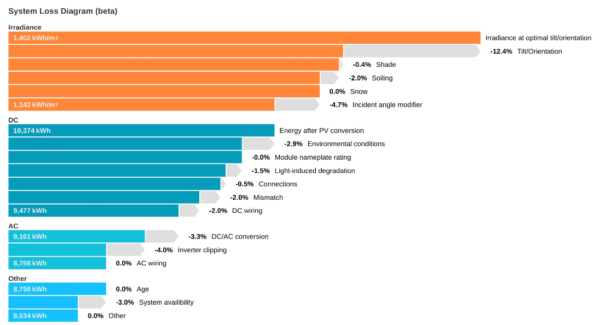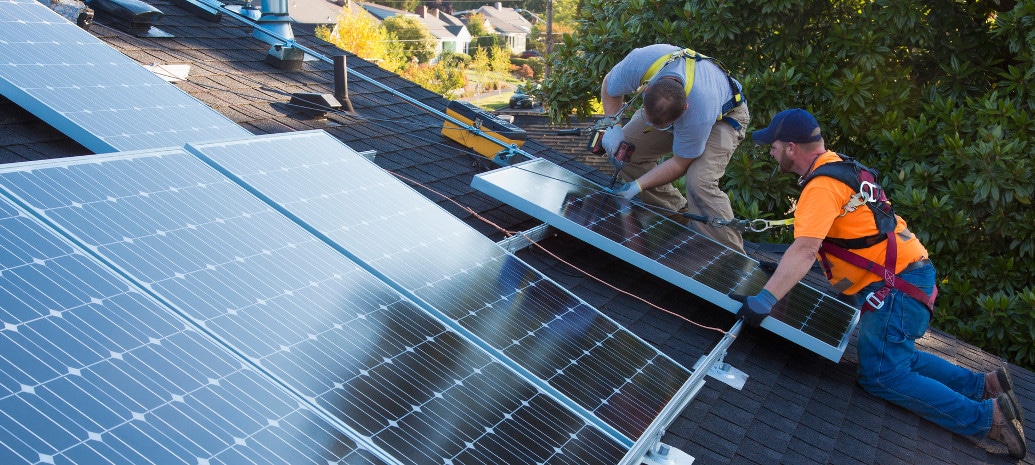From pv magazine Global
When investing in solar, maximizing production is a common goal. Aurora Solar, a leading solar design and performance software provider, released a guide for understanding the leading causes of energy loss in PV systems, and how to avoid them.
KWh Analytics, a climate insurance and renewable energy risk management firm, released its 2022 Solar Generation Index and reports that solar assets are broadly performing below expectations. Systems installed since 2015 have broadly underperformed expectations by 7% to 15%, with some regional difference. How can this underperformance be avoided?
Aurora Solar’s Ultimate Guide to PV System Losses includes basic solar performance concepts like the effect of tilt, orientation, and shade on production metrics. The guide walks through how mismatched equipment can cause losses and surveys the effects of incident angle modifiers, and module nameplate rating losses.

Tilt and orientation
The angle of panels affects the amount of solar irradiance the system receives over the course of a year. Tilting the array towards the equator will maximize incident irradiance, boosting production, the Aurora report notes.
Making the most of the solar incidence angle is important for production, too. Incidence angle refers to the angle of the panel’s surface compared to the sun’s rays. Incidence angles affect the amount of sunlight that gets through the glass on the front of the panel.
Aurora said that these losses, measured as the incident angle modifier, typically range between 3% to 4.5%. The DeSoto model is used to understand incidence angle modifier effects.
Soiling, or the buildup of dust and other debris on the surface of the panel, is a leading cause of energy loss in some regions. In areas with long dry seasons, it can lead to 5% losses. In regions with frequent dust deposits, it can add 1% to 2% to that figure, and locations near major traffic areas typically have another 1% in losses. In regions with year-round rain, soiling losses typically hover around 2%, Aurora said.
The National Renewable Energy Laboratory (NREL) performance parameters suggests a 5% typical soiling loss in the United States is common. An NREL model found that having one annual cleaning on a system with 1.9% soiling loss would decrease the loss to around 1.5%. Two cleanings per year could drop the average loss to 1.3%, and three cleanings per year would reduce it further to a 1.2% average annual loss. An NREL locational analysis on soiling effects can be found here.
Birds and bird droppings are another production concern. Bird droppings substantially block one or two cells and may not wash away with rain. In modules without bypass diodes, one or two cells being entirely blocked could lead to the entire module losing operation. Aurora advises quick manual cleaning of bird droppings.
Snow loads are another mitigating factor. An NREL study calculated losses ranging from 10-30% for fixed-tilt systems. Snow factors can be difficult to model accurately on an annualized basis, so Aurora recommends measuring on a monthly format. A locational study on snow loss estimates based on various panel tilts can be found here.
Shading is another critically important aspect of system performance. Aurora likens a shaded solar cell to a clog in a pipe. When a cell is shaded, the current through the entire string of cells is reduced. Panels integrate bypass diodes, which allow the array to “skip over” the shaded cell, but at the expense of foregoing any production that could have been harvested from that cell. A Stanford University analysis of shading effects can be found here.
Aurora suggests using module-level power electronics (MLPE) or microinverters to avoid losses from shading.
Environmental losses
Temperature coefficients are another factor to consider in performance. A temperature coefficient is measured as the percentage energy output decreases for every 1-degree Celsius increase above the reference point of 25 degrees Celsius (77 degrees Fahrenheit).
Certain roofing materials will absorb more heat than others, affecting performance. Panel angles can alter temperature, and Aurora said flat mounted panels typically get hotter. Panel type makes a difference, too. Thin-film panels typically have a lower temperature coefficient than monocrystalline or polycrystalline solar panels.
Modules on systems with mismatched or long strings can lose another 0.01% to 3% of total production. Aurora uses an assumption of 2% in its modeling for this loss category. Mismatched modules with tight wattage tolerances can lead to another 1% system loss.
Light-induced degradation occurs when the electrical characteristics of crystalline silicon solar cells change when they’re exposed to light. Losses range from 0.5% to 1.5% and happen within the first few hours of the new panel’s exposure.
Module nameplate rating losses represent the loss due to the difference in the stated power of the module compared with how it actually performs at standard test conditions. Aurora suggests no loss occurs in this category for modern modules, as most accurately reflect standard test results.
However, some providers may list a performance range, referred to as “power tolerance”. It is typically expressed as a plus-or-minus percentage. For example, a 250 W panel with a listed +/- 5% power tolerance may produce between 237.5 W to 262.5 W.
Cable concerns
Wiring losses typically contribute to another 2% in system losses. If the project uses thicker wires on short runs, those losses may be closer to 1%.
“Several components can cause a voltage drop in circuits, including connections, fuses, and resistors. Differences in cable length or size among the parallel strings can also introduce a voltage drop,” according to Aurora.
An NREL study modeled connection losses can contribute to another 0.5% loss. Wiring connectors and bypass diodes have physical imperfections that cause resistance, leading to small voltage drops.
Inverter efficiency measures how efficiently DC energy is converted to AC energy. Inverter manufacturers provide both a maximum efficiency rating for performance in ideal conditions, and a weighted efficiency rating for its performance over a range of conditions.
“It’s important to look at the weighted efficiency because an inverter’s efficiency will change based on the capacity it’s carrying. Most inverters peak around 20% load and fall slightly as the load reaches the maximum input rating,” said the Aurora report.
Inverter clipping often occurs in systems at the height of sunny days. When DC output from the panels is greater than the amount of DC power the inverter can convert, clipping loss occurs. Aurora’s NEC Validation Report can help properly size inverters.
Publicly available system performance model PVWatts uses a default value of a 3% system availability loss. Aurora said that systems with operations and maintenance or fault alert systems set up may experience availability losses of only 0.5%. Availability includes inverter shutdowns or failures, grid outages, and other events that disconnect the PV system.
Thermal expansion and contraction, UV light, and damage from windblown particles will reduce production over time. Solar panel manufacturer production guarantees provide conservative estimate for production under panel degradation over time.
This content is protected by copyright and may not be reused. If you want to cooperate with us and would like to reuse some of our content, please contact: editors@pv-magazine.com.









By submitting this form you agree to pv magazine using your data for the purposes of publishing your comment.
Your personal data will only be disclosed or otherwise transmitted to third parties for the purposes of spam filtering or if this is necessary for technical maintenance of the website. Any other transfer to third parties will not take place unless this is justified on the basis of applicable data protection regulations or if pv magazine is legally obliged to do so.
You may revoke this consent at any time with effect for the future, in which case your personal data will be deleted immediately. Otherwise, your data will be deleted if pv magazine has processed your request or the purpose of data storage is fulfilled.
Further information on data privacy can be found in our Data Protection Policy.